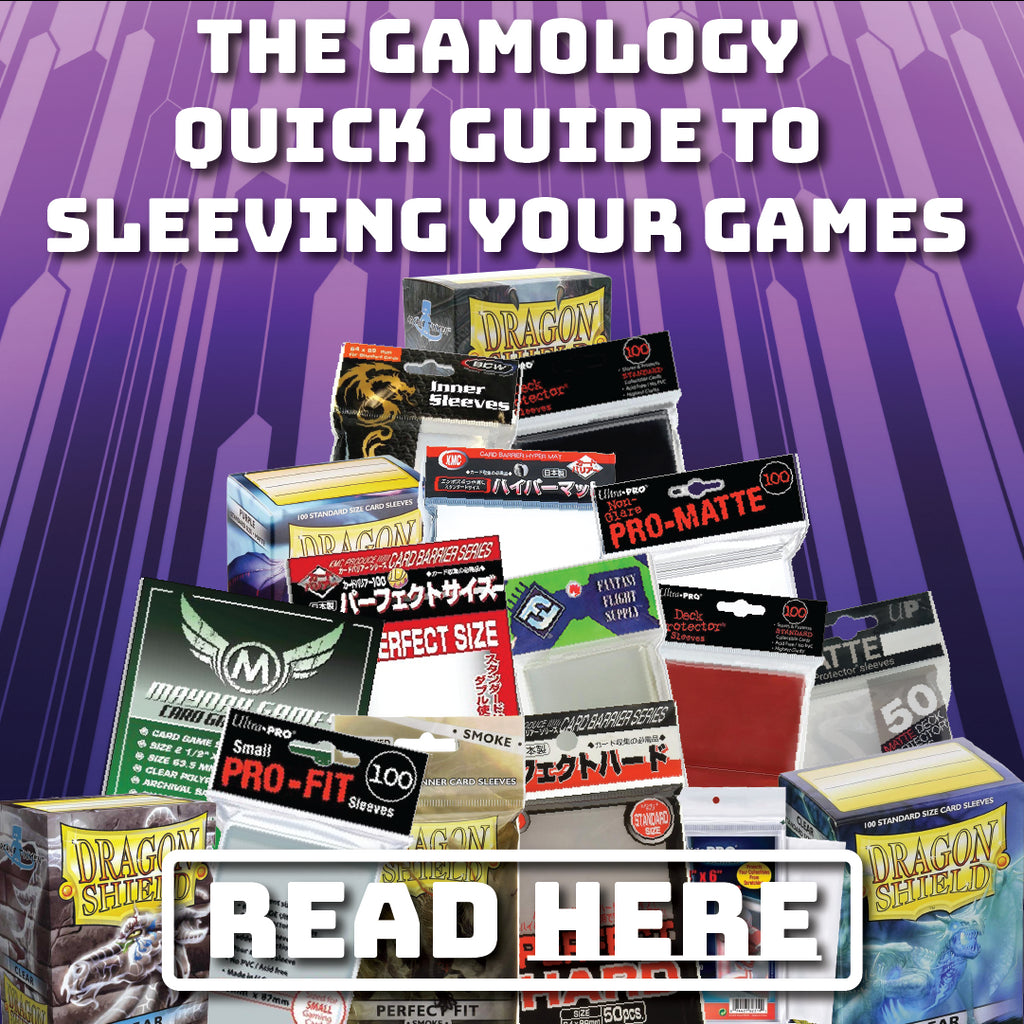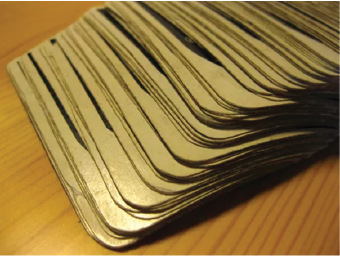The Gameology Quick Guide to Sleeving Your Games
Posted by GAMEOLOGY

Sleeves. Those little plastic thingies that protect your cards. With such a huge variety of brands and sizes and thicknesses, where do you begin?
If you’re looking to start sleeving your games, this is the guide for you.
The Purpose of Sleeves

So...why do we sleeve games? Well, the obvious answer is to protect the cards. But what does that really mean?
Cards, especially those that are shuffled or handled frequently, can soon show wear and tear, often so slowly you don’t realise until it’s too late. Frayed edges, oily fingerprints, water damage, bent corners. All these are what players try to prevent with card sleeves.

If you are a TCG player or collector, this is particularly important as it ensures your valuable and highly sought-after cards are protected because at this point, they’re basically investments.
Even for board gamers, sleeving is important. Sometimes board games go out of print or are just incredibly expensive or difficult to replace. Sure, if a copy of UNO gets messed up, it’s easy and cheap to replace. But your Kickstarter edition board games with exclusive promo cards? I don’t even want to imagine the horror.
Of course, sleeving is not for everyone. Some people enjoy seeing the history and age of the cards as they play them, the same way that people enjoy seeing well-worn books. It speaks of the enjoyment and time surrounding the game.
However, if you are someone that wants to start sleeving your games, read on.
Check Size and Quantity

The first thing you need to do is determine the size/s of the cards in the board game you want to sleeve and also how many cards there are. This can be done easily with websites like Sleeve Your Games, or by printing out a size chart from sleeve companies like Mayday Games (https://www.maydaygames.com/products/mayday-games-sleeve-finder) or Board Game Sleeves (https://www.boardgamesleeves.com/). Some games even have the sleeves you need listed on the back of the box, usually in some kind of colour code for a specific brand. If you come along to our retail store and bring a card from the game, we can even help you size it in-store.
Usually the card size will have a name like Standard American, Mini European or Yucatan. Sleeve companies can be inconsistent with what dimensions they write on their sleeve packaging, but in general, all cards of a certain size (eg: Mini Euro) will fit sleeves labelled as that size, despite minor differences in measurements.
If you can’t seem to find the correct size and its name, try checking the cards against other games in your collection or online. If the cards are the same size as another game, particularly a popular one like Dixit, Catan or Magic: The Gathering, that can help you on your search.
Determine Budget

After you’ve got your sleeve sizes and quantities (eg: I need 150 sleeves in European size), the next step is determining how much you want to spend on sleeving your game. Sleeves can range from dirt cheap to even more expensive than a big board game! Some things you might want to consider when allocating your budget are:
- How important is the game to you? Is it a game near and dear to your heart? Was it the first board game you ever bought? Was it expensive?
- How much are the cards handled during play? Is it a deck-building game with lots of shuffling? Or do the cards simply sit on the table in a tableau? Do they get passed between players often?
- Is it important if a card gets damaged? Will it reveal information that is meant to be hidden? Will it throw off the balance of the game if you removed a single card?
Here are some personal examples to help you contextualise these questions:
Dominion - Despite the fact that this is my favourite board game, it involves a lot of shuffling and I have invested a considerable amount of money into it and five expansions, I have not sleeved Dominion. Why? Because there are so many cards that even with the cheapest sleeves, it would cost well over the price of a new copy of the base game. Since the cards that get ruined fastest are the base game cards, I would prefer to buy a new base game with that money instead of buying sleeves.
Nemesis - This was the first game I sleeved, mostly because it was very expensive. I cannot fathom the idea of having to buy a brand new copy of Nemesis, so I would prefer to spend an extra bit of money now, instead of well over $200 later. Plus, the cards are mostly black so wear and tear would be extremely obvious.
Villagers - This is a medium-weight card game. I think it’s a pretty good game, but it’s nowhere near a favourite. Why did I sleeve it? Because the cards are white. I feel a lot safer now bringing it to my friend’s house and eating snacks while playing because I am no longer worried about snack smudges.
Assess Your Options
There are so many sleeve brands it can be incredibly overwhelming. When I first started working at Gameology, I was overwhelmed too. What I have compiled here is a quick list of some of the brands we sell, divided into categories with estimate prices to help you make your choice.
Tier 1: Inner Sleeves

These include:
- Ultra Pro Pro-Fit sleeves
- KMC Perfect
- BCW Inner Sleeves
Often priced: up to $6 per 100 sleeves
Very thin and ultra-fitted to the card, these only come in standard size (like MTG and Pokemon) and are designed to go on trading cards before placing them inside a larger “outer” sleeve. Where most sleeves leave 0.5-1mm of plastic around the card to cushion it, inner sleeves fit tight, leaving the top edge of the card basically exposed. Recommended for double sleeving and for standard size cards that don’t get much play.
Tier 2: Thin Sleeves

These include:
- Mayday Standard (usually their 100 packs)
- Sleeve Kings
- Ultra Pro Board Game Sleeves Lite
Often priced: up to $10 per 100 sleeves
Thicker and more comfortably sized than inner sleeves, the benefits of these sleeves are that they protect, without adding too much bulk to the cards. They come in a wide variety of sizes and are much cheaper than their thicker variants. Recommended for games with lots of cards or games where the box does not allow much room.
Tier 3: Thick Sleeves

These include:
- TCG Outer sleeves (like Ultra Pro Deck Protectors and KMC Hyper Mats)
- Mayday Premium
- Dragon Shield
- Arcane Tinmen Board Game Sleeves (both the regular and non-glare variants)
- Fantasy Flight
- Gamegenic
- Ultra Pro Board Game Sleeves
Often priced: up to $20 per 100 sleeves
Unlike the thin sleeves, these will add considerable bulk to your cards. Decks can double in size when sleeved with thick sleeves. However, if you are looking for ultimate protection, these are the way to go—though they will cost you. Recommended for games where you want max protection.
*
And there you go—a quick guide to start sleeving your games. Do you have any other sleeving tips or insights? Be sure to leave them in the comments below!




























